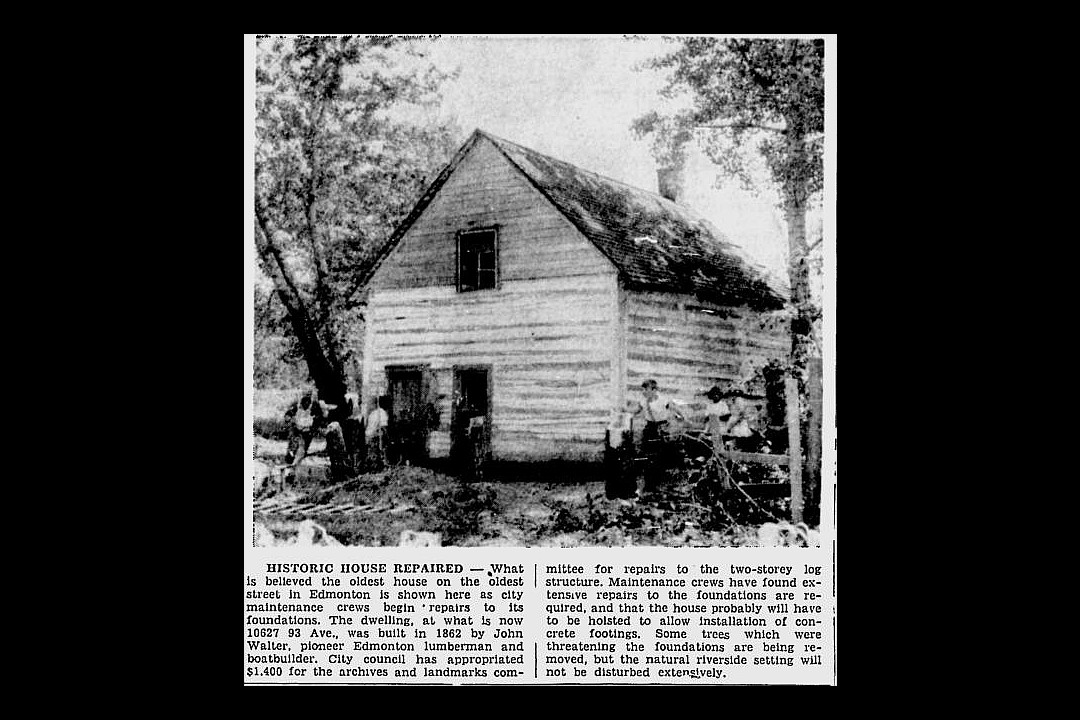On this day in 1958, repairs were underway on a house built by John Walter, one of the city's most influential residents.
Walter first came to the area in 1870, on a five-year contract to build York boats for the Hudson's Bay Company. When the contract ended, Walter created his own boat-building business, though HBC remained one of his main customers. He didn't know it then, but the decision marked the beginning of a business empire that would make him one of the city's wealthiest individuals.
Walter built his house beside the North Saskatchewan River on a 155-acre plot of land near what is now 109 Street, extending south from the riverbank to the current University Avenue. There, Walter built his two-storey log house, and ran his business from it.
By 1882, Strathcona and Edmonton were growing on either side of the river. Without bridges, Walter saw the need for easy travel between the two. He set up a cable ferry — essentially a small boat guided along a rope or cable. It was a simple setup, but it allowed relatively easy travel between the two growing towns.
That success led Walter to establish further businesses along the river flats, including a blacksmith shop, a freight company, a small coal mine, and two sawmills. Walter's boatbuilding company created two steamships, the City of Strathcona and the City of Edmonton, which connected Edmonton and Strathcona residents to other settlements along the river. Ever the savvy businessman, Walter also used the ships to take residents on recreational trips to the land he owned on Big Island, located across the river from the current-day neighbourhood of Windermere.
Walter also expanded his property, building two additional homes that he often used to board new arrivals looking to establish themselves in the area. Eventually, others built homes and businesses nearby, and in 1907, what had become a neighbourhood was dubbed Walterdale.
In addition to his business reputation, Walter was known for his generosity and dedication to the community. He played an active part in establishing the Strathcona school board, and he helped provide funding and building materials for schools, churches, and other civic buildings. The Edmonton Bulletin newspaper described him as a man "who lived and died without an enemy.""
But Walter's fortunes collapsed almost as quickly as they grew. It started in 1907, when an accident at a coal mine he partially owned killed six workers. This had a profound effect on Walter. Over the next few years, fires and flooding destroyed some of his other businesses. And when the High Level Bridge opened in 1913, his ferry service was no longer needed to cross the river (a fact that Walter apparently celebrated).
But the most significant blow came in 1915. That's when the worst flood in the city's history washed away many of Walter's businesses and industrial sites along the river, including his sawmills. His businesses never fully recovered. Five years later, Walter passed away following an operation.
While the river may have wiped away his empire, Walter's legacy remains. The three homes he built are now historically protected and form the John Walter Museum near the Kinsmen Sports Centre. In addition to the Walterdale neighbourhood, his name is also on the Walterdale Bridge, which is a fitting linkage for someone who helped people get across the river. The Walterdale Bridge may become even more vital in the future, as there are discussions to temporarily convert it to two-way traffic, to ease congestion, while three other bridges undergo major renovations over the next few years.
This clipping was found on Vintage Edmonton, a daily look at Edmonton's history from armchair archivist Rev Recluse of Vintage Edmonton.

